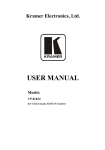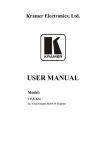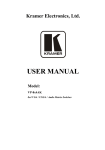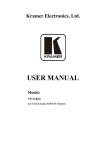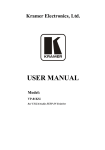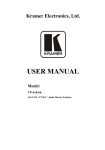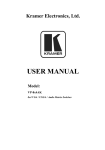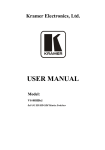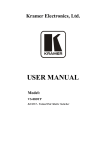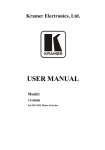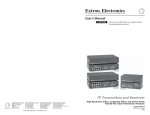Download Kramer Electronics VP-16X18AK video switch
Transcript
Kramer Electronics, Ltd.
USER MANUAL
Model:
VP-16x18AK
16 x 18 PC UXGA/Audio Router
Contents
Contents
1
2
2.1
2.2
3
3.1
3.2
3.3
4
4.1
5
6
6.1
6.2
6.3
6.4
6.5
Introduction
Getting Started
Recycling Kramer Products
Quick Start
Overview
Recommendations for Best Performance
Safety Instructions
Shielded Twisted Pair and Unshielded Twisted Pair
Defining the VP-16x18AK 16 x 18 PC UXGA/Audio Router
Using the IR Transmitter
Installing the VP-16x18AK in a Rack
Connecting and Configuring the VP-16x18AK
Connecting the VP-16x18AK
Connecting the Audio Outputs to Balanced/Unbalanced Acceptors
Connecting to the VP-16x18AK via RS-232
Connecting to the VP-16x18AK via RS-485
Connecting to the VP-16x18AK via the Ethernet Port
1
1
2
2
4
5
5
6
7
11
12
13
13
14
15
15
16
6.5.1
6.5.2
6.5.3
Connecting Directly to the Ethernet Port
Connecting via a Network Hub, Switch, or Router
Configuring the Ethernet Port on the VP-16x18AK Using K-Upload
16
18
18
6.6
7
7.1
7.2
7.3
Setting the RS-485 Termination and Machine Number DIP-switches
Operating the VP-16x18AK Locally via the Front Panel Buttons
The Status Display
Switching Inputs to Outputs
The At Once and Confirm Modes
18
20
20
20
21
7.3.1
7.3.2
Toggling between At Once and Confirm Modes
Confirming a Switching Action
21
21
7.4
7.5
7.6
Setting the Audio Gain for Inputs and Outputs
Audio Output Bass and Treble Level Setting
Setting the Audio-Follow-Video or Breakaway Option
22
22
23
7.6.1
7.6.2
Setting the Audio-Follow-Video Option
Setting the Breakaway Option
23
23
7.7
Storing and Recalling Setup Configurations
23
7.7.1
7.7.2
Storing a Setup Configuration
Recalling a Setup Configuration
24
24
7.8
7.9
8
8.1
Locking and Unlocking the Front Panel Buttons
Reading and Writing the EDID
Operating the VP-16x18AK Remotely
Operating the VP-16x18AK via RS-232
24
24
25
25
i
Contents
9
9.1
9.2
Operating the VP-16x18AK Remotely Using a Web Browser
Connecting to the VP-16x18AK via your Browser
The Main Switching Matrix Page
27
27
29
9.2.1
9.2.2
9.2.3
9.2.4
9.2.5
Switching an Input to an Output
Setting the AFV Mode
Operating in the Offline Mode
Storing and Recalling Setups
Locking the Front Panel Buttons
30
30
31
32
34
9.3
9.4
10
11
12
13
14
15
16
16.1
Audio Input Gain Control Page
The Configuration Page
Firmware Upgrade Using K-Upload
Technical Specifications
Default Communication Parameters
Factory Default EDID
Table of ASCII Codes for Serial Communication (Protocol 3000)
Table of Hex Codes for Serial Communication (Protocol 2000)
Kramer Protocol
Switching Protocols
34
35
36
37
38
38
40
41
43
43
16.1.1 Switching Protocols via the Front Panel Buttons
16.1.2 Switching Protocols via Protocol Commands
43
43
16.2
Kramer Protocol 3000
43
16.2.1 Protocol 3000 Syntax
16.2.2 Command Parts Details
44
44
16.3
51
Kramer Protocol 2000
Figures
Figure 1: VP-16x18AK 16 x 18 PC UXGA/Audio Router Front Panel
Figure 2: VP-16x18AK 16 x 18 PC UXGA/Audio Router Rear Panel
Figure 3: Connecting the VP-16x18AK 16 x 18 PC UXGA/Audio Router
Figure 4: Connecting to a Balanced Acceptor
Figure 5: Connecting to an Unbalanced Acceptor
Figure 6: Local Area Connection Properties Window
Figure 7: Internet Protocol (TCP/IP) Properties Window
Figure 8: VP-16x18AK DIP-switches
Figure 9: Control Configuration via RS-232
Figure 10: Java Test Page Success Message
Figure 11: Entering the IP Address in the Address Bar
Figure 12: The Loading Page
Figure 13: First Time Security Warning
Figure 14: Main Switching Matrix Page
Figure 15: Selecting a Switching Point on the Matrix
Figure 16: Switching an Input to an Output
Figure 17: AFV Mode Warning
ii
7
9
14
14
15
17
17
18
26
27
27
28
28
29
30
30
31
KRAMER: SIMPLE CREATIVE TECHNOLOGY
Contents
Figure 18: AFV Mode Audio Channels Switched
Figure 19: Switching Audio in the Offline Mode
Figure 20: Exiting Offline Warning
Figure 21: Selecting Preset 07
Figure 22: Selecting Preset 03
Figure 23: Recalling a Preset in Offline Mode
Figure 24: Audio Gain Control Page
Figure 25: Selecting Audio Input Gain for Channel 2
Figure 26: Configuration Page
31
32
32
33
33
34
34
35
35
Tables
Table 1: VP-16x18AK 16 x 18 PC UXGA/Audio Router Front Panel Features
Table 2: VP-16x18AK 16 x 18 PC UXGA/Audio Router Rear Panel Features
Table 3: DIP-switch Settings
Table 4: Machine Number DIP-switch Settings
Table 5: Technical Specifications of the VP-16x18AK
Table 6: Communication Parameters
Table 7: VP-16x18AK Video Signal Codes for Protocol 3000
Table 8: VP-16x18AK Audio Signal Codes for Protocol 3000
Table 9: VP-16x18AK Audio Input Gain Codes
Table 10: VP-16x18AK Audio Output Gain Codes
Table 11: VP-16x18AK Hex Codes for Switching Video Channels via RS-232/RS-485
Table 12: VP-16x18AK Hex Codes for Switching Audio Channels via RS-232/RS-485
Table 13: VP-16x18AK Hex Codes for Increasing/Decreasing the Audio Input Gain
Table 14: VP-16x18AK Hex Codes for Setting the Audio Input Gain
Table 15: VP-16x18AK Hex Codes for Increasing/Decreasing the Output Gain
Table 16: VP-16x18AK Hex Codes for Setting the Audio Output Gain
Table 17: Instruction Codes for Protocol 3000
Table 18: Protocol Definitions
Table 19: Instruction Codes for Protocol 2000
8
10
18
19
37
38
40
40
40
41
41
41
41
42
42
42
45
51
52
iii
Introduction
1
Introduction
Welcome to Kramer Electronics! Since 1981, Kramer Electronics has been
providing a world of unique, creative, and affordable solutions to the vast
range of problems that confront video, audio, presentation, and broadcasting
professionals on a daily basis. In recent years, we have redesigned and
upgraded most of our line, making the best even better! Our 1,000-plus
different models now appear in 11 groups 1 that are clearly defined by
function.
Congratulations on purchasing your VP-16x18AK, 16 x 18 PC
UXGA/Audio Router which is ideal for the following typical applications:
• Professional display systems requiring a true 16x18 computer
graphics and audio matrix operation
• Multimedia and presentation source and acceptor selection
The package includes the following items:
• VP-16x18AK, 16 x 18 PC UXGA/Audio Router
• Kramer RC-IR3 Infrared Remote Control transmitter (including the
required battery and a separate user manual 2)
• Power cord 3, rack “ears” and this user manual2
2
Getting Started
We recommend that you:
• Unpack the equipment carefully and save the original box and
packaging materials for possible future shipment
• Review the contents of this user manual
i
Go to http://www.kramerelectronics.com to check for up-to-date user
manuals, application programs, and to check if firmware upgrades
are available (where appropriate).
1 GROUP 1: Distribution Amplifiers; GROUP 2: Switchers and Routers; GROUP 3: Control Systems; GROUP 4:
Format/Standards Converters; GROUP 5: Range Extenders and Repeaters; GROUP 6: Specialty AV Products; GROUP 7:
Scan Converters and Scalers; GROUP 8: Cables and Connectors; GROUP 9: Room Connectivity; GROUP 10: Accessories
and Rack Adapters; GROUP 11: Sierra Products
2 Available from http://www.kramerelectronics.com
3 We recommend that you use only the power cord that is supplied with this machine
1
Getting Started
2.1
Recycling Kramer Products
The Waste Electrical and Electronic Equipment (WEEE) Directive
2002/96/EC aims to reduce the amount of WEEE sent for disposal to
landfill or incineration by requiring it to be collected and recycled. To
comply with the WEEE Directive, Kramer Electronics has made
arrangements with the European Advanced Recycling Network (EARN)
and will cover any costs of treatment, recycling and recovery of waste
Kramer Electronics branded equipment on arrival at the EARN facility. For
details of Kramer’s recycling arrangements in your particular country go to
our recycling pages at
http://www.kramerelectronics.com/support/recycling/.
2.2
Quick Start
This quick start chart summarizes the basic setup and operation steps.
2
KRAMER: SIMPLE CREATIVE TECHNOLOGY
Getting Started
3
Overview
3
Overview
The VP-16x18AK is a high performance, 16x18 computer graphics video
matrix router for high resolution video and stereo audio signals. The
VP-16x18AK is HDTV compatible and lets you simultaneously route any
or all of the 16 inputs to any or all of the 18 outputs.
In particular, the VP-16x18AK, 16 x 18 PC UXGA/Audio Router features:
• Kramer’s innovative integrated sync processing; Kr-isp® technology
provides a sharp, stable image by restoring the signal waveform even
when the sync level is too low
• A video bandwidth of over 300MHz that ensures transparent
performance even for the most critical applications
• 12 preset memory locations for quick access to common routing
configurations and audio gain status for each output
• Automatic detection of inputs with live connections (the respective
input button lights green)
• A delayed switching mode (ranging from 0 to 3.5sec 1) for clean
transitions when switching between non-genlocked sources
• DC-coupled video inputs and outputs
• Audio-follow-video and breakaway options
• 16 VGA (up to UXGA) video inputs on 15-pin HD connectors
• 16 unbalanced, stereo audio inputs on 3.5mm mini jacks
• 16 VGA (up to UXGA) video outputs on 15-pin HD connectors
• 16 balanced stereo audio outputs on 5-pin, removable terminal block
connectors
• Two Twisted Pair outputs on RJ-45 connectors
• Audio level control buttons for adjusting the volume of each input
and output
• Bass and treble control for each output
• The ability to place multiple switching actions in a queue and then to
activate them simultaneously with a one touch button
• The ability to lock the front panel buttons to prevent tampering with
settings
• Support for DDC (Display Data Channel) communication between
input 1 and output 1 high-density 15-pin HD connectors on pins 12
and 15
• Default EDID values programmed on each input
1 In ½ second increments
4
KRAMER: SIMPLE CREATIVE TECHNOLOGY
Overview
You can operate the VP-16x18AK using the front panel buttons, or
remotely via:
• RS-485, RS-232 serial or Ethernet TCP/UDP commands (using
Kramer 2000 and 3000 protocols) transmitted by a touch screen
system, PC or other serial/Ethernet controller
• The Kramer Infrared Remote Control transmitter or Infrared remote
extension cable transmitter (optional)
• Your Web browser using Ethernet communication over a LAN
The VP-16x18AK is dependable, rugged and fits into three vertical spaces
(3U) of a standard 19” professional rack.
3.1
Recommendations for Best Performance
To achieve the best performance:
• Use only high quality connection cables 1 (we recommend Kramer
high-performance, high-resolution cables) to avoid interference,
deterioration in signal quality due to poor matching, and elevated
noise levels (often associated with low quality cables)
• Do not secure the cables in tight bundles or roll the slack into tight
coils
• Avoid interference from neighboring electrical appliances that may
adversely influence signal quality
• Position your Kramer VP-16x18AK away from moisture, excessive
sunlight and dust
!
3.2
This equipment is to be used only inside a building. It may only be
connected to other equipment that is installed inside a building.
Safety Instructions
!
Caution:
There are no operator serviceable parts inside the unit
Warning:
Use only the power cord that is supplied with the unit
Warning:
Do not open the unit. High voltages can cause electrical
shock! Servicing by qualified personnel only
Warning:
Disconnect the power and unplug the unit from the wall
before installing
1 Available from Kramer Electronics and listed on our Web site at http://www.kramerelectronics.com
5
Overview
3.3
Shielded Twisted Pair and Unshielded Twisted Pair
We recommend that you use Shielded Twisted Pair (STP) cable, and stress
that the compliance to electromagnetic interference was tested using STP
cable. There are different levels of STP cable available, and we advise you
to use the best quality STP cable that you can afford. Our non-skew-free
cable, Kramer BC-STP is intended for analog signals where skewing is not
an issue.
In cases where there is skewing, our Unshielded Twisted Pair (UTP) skewfree cable, Kramer BC-XTP, may be advantageous, and UTP cable might
also be preferable for long range applications. In any event when using UTP
cable, it is advisable to ensure that the cable is installed far away from
electric cables, motors and so on, which are prone to create electrical
interference.
6
KRAMER: SIMPLE CREATIVE TECHNOLOGY
Defining the VP-16x18AK 16 x 18 PC UXGA/Audio Router
4
Defining the VP-16x18AK 16 x 18 PC UXGA/Audio Router
Figure 1 and Table 1 define the front panel of the VP-16x18AK 16 x 18 PC UXGA/Audio Router.
Figure 1: VP-16x18AK 16 x 18 PC UXGA/Audio Router Front Panel
7
Defining the VP-16x18AK 16 x 18 PC UXGA/Audio Router
Table 1: VP-16x18AK 16 x 18 PC UXGA/Audio Router Front Panel Features
#
1
Feature
SELECTOR IN Buttons
2
3
SELECTOR OUT
Buttons
OFF Button
4
5
6
7
8
9
ALL Button
STATUS LCD Readout
IR Sensor
IR LED
POWER LED
VIDEO Button
10
AUDIO Button
11
TAKE Button
12
13
AFV Button
RCL (Recall) Button
14
STO (Store) Button
15
16
17
18
AUDIO
LEVEL
AUDIO GAIN Button
– Button
+ Button
LOCK Button
Function
Press to select an input (from 1 to 16) following the selection of an output (see Section 7.2).
When an input signal is detected, the corresponding input button lights
Press to select an output (from 1 to 18) followed by an input selection (see Section 7.2)
Press a SELECTOR OUT button followed by OFF to disconnect the selected output from the input (see Section 7.2).
Press ALL followed by OFF to disconnect all outputs
Press ALL followed by an INPUT button to switch the selected input to all outputs 1 (see Section 7.2)
2
Displays the current Input-Output switching configuration on a 2 line LCD readout
IR receiver for the Remote Control IR transmitter
Lights yellow when a signal is received from the IR transmitter
Lights green when the unit receives power and is switched on
Press for subsequent actions to relate to video. The button lights when the video mode is active.
Press in conjunction with AUDIO to set the delay time
Press for subsequent actions to relate to audio. The button lights when the audio mode is active.
Press in conjunction with VIDEO to set the delay time
Press to set the Confirm mode 3 (where user confirmation is required for switching actions); press again to set the At Once mode (where
user confirmation per action is not required). When in Confirm mode, press the TAKE button to execute pending actions (see Section 7.3.2)
Press to make the audio channels follow the video channel switching. The button lights when the AFV mode is active (see Section 7.6)
Press in conjunction with an Output button to recall a switching preset (see Section 7.7.2). Press again to execute the preset.
Press in conjunction with STO to set the machine number
Press followed by an Output button to store the current switching configuration (see Section 7.7.1).
Press in conjunction with RCL to set the machine number
Press (following selection of an output or input) to set the audio input or output gain (see Section 7.4)
Press (following the Audio Gain button) to decrease the audio signal level (input, output, bass or treble)
Press (following the Audio Gain button) to increase the audio input signal level (input, output, bass or treble)
Press and hold to lock the front panel buttons, press and hold again to unlock the buttons. The button lights when the front panel is locked
(see Section 9.2.5)
1 For example, press ALL and then IN button 2 to connect input 2 to all the outputs
2 Also displays the number of input and output ports, the firmware version number and the machine number (see Section 6.6)
3 When in the Confirm mode, the TAKE button lights
8
KRAMER: SIMPLE CREATIVE TECHNOLOGY
Defining the VP-16x18AK 16 x 18 PC UXGA/Audio Router
Figure 2 and Table 2 define the rear panel of the VP-16x18AK 16 x 18 PC UXGA/Audio Router.
Figure 2: VP-16x18AK 16 x 18 PC UXGA/Audio Router Rear Panel
9
Defining the VP-16x18AK 16 x 18 PC UXGA/Audio Router
Table 2: VP-16x18AK 16 x 18 PC UXGA/Audio Router Rear Panel Features
#
1
2
5
Feature
VIDEO INPUTS 15-pin HD (F) Connectors
AUDIO OUTPUTS Removable Terminal Block
Connectors
VGA 15-pin HD (F)
Connectors
VIDEO OUTPUTS
OUTPUT 17, OUTPUT 18
RJ-45 TP Connectors
REMOTE IR Opening 2
6
7
AUDIO INPUTS 3.5mm Mini Jacks
RESET Button
8
9
PROG Button
RS-485 3-pin Terminal Block
10
11
12
13
RS-232 9-pin D-sub Serial Port
ETHERNET RJ-45 Connector
MACH # DIP-switches (1, 2 and 3)
RS-485 TERM DIP-switch (4)
14
15
16
Mains Power Connector
Fuse Holder
Power Switch
3
4
Function
1
Connect to the VGA sources (from 1 to 16)
Connect to balanced stereo audio acceptors (from 1 to 16)
1
Connect to the VGA acceptors (from 1 to 16)
Connect to compatible TP receivers (for example, TP-122N/TP-142)
Mount the optional internal IR connection cable that connects to an external IR receiver unit for
controlling the machine via an IR remote controller instead of using the front panel IR receiver
Connect to the unbalanced stereo audio sources (from 1 to 16)
Press and hold while powering up the unit to reset all audio, switching and Ethernet settings to
their factory default values (see Section 12)
For the use of Kramer service personnel only
Connect to the corresponding pins A(+), B(–) and G on another device for RS-485
communication (see Section 6.4)
Connect to a PC or remote controller (see Section 6.3)
Connect to a PC or other controller over a LAN (see Section 6.5)
Use to set the RS-485 machine number (see Section 6.6)
3
Use to set the RS-485 termination : ON (down) for RS-485 line termination with 120Ω;
OFF (up) for no RS-485 line termination (see Section 6.6)
Connect to the AC mains power supply
Mains fuse holder
Switch for turning the unit on and off
1 Up to UXGA resolution
2 Covered by a removable cap. The 3.5mm mini jack at the end of the internal IR connection cable fits into this opening
3 Terminate the first and the last physical units on the RS-485 bus (on). Leave all other units unterminated (off)
10
KRAMER: SIMPLE CREATIVE TECHNOLOGY
Defining the VP-16x18AK 16 x 18 PC UXGA/Audio Router
4.1
Using the IR Transmitter
You can use the RC-IR3 IR transmitter to control the machine via the
built-in IR receiver on the front panel or, instead, via an optional external IR
receiver 1. The external IR receiver can be located up to 15m (50ft) away
from the machine. This distance can be extended to up to 60m (200ft) when
used with three extension cables 2
Before using the external IR receiver, be sure to arrange for your Kramer
dealer to insert the internal IR connection cable 3 with the 3.5mm jack that
fits into the REMOTE IR opening on the rear panel. Connect the external IR
receiver to the REMOTE IR 3.5mm jack.
13F
1 Model: C-A35M/IRR-50
2 Model: C-A35M/A35F-50
3 P/N: 505-70434010-S
11
Installing the VP-16x18AK in a Rack
5
Installing the VP-16x18AK in a Rack
This section describes what to do before installing in a rack and how to rack
mount the VP-16x18AK.
.
12
KRAMER: SIMPLE CREATIVE TECHNOLOGY
Connecting and Configuring the VP-16x18AK
6
Connecting and Configuring the VP-16x18AK
This section describes how to:
• Connect the VP-16x18AK (see Section 6.1)
• Connect a balanced stereo audio output (see Section 6.2)
• Connect the VP-16x18AK to a remote control device via:
RS-232 (see Section 6.3)
RS-485 (see Section 6.4)
Ethernet (see Section 6.5)
• Set the RS-485 termination and machine number (see Section 6.6)
6.1
Connecting the VP-16x18AK
i
Always switch off the power on each device before connecting it to your
VP-16x18AK. After connecting your VP-16x18AK, connect its power
and then switch on the power on each device.
To connect 1 the VP-16x18AK, as illustrated in the example 2 in Figure 3:
1. Connect the VGA (up to UXGA) sources (for example, computer
graphics sources) to the 15-pin HD VIDEO INPUT connectors.
2. Connect the unbalanced stereo audio sources (for example, the audio
source of the computer) to the 3.5mm mini AUDIO INPUT jacks.
3. Connect the 15-pin HD VGA VIDEO OUTPUT connectors to the
video acceptors (for example, video displays).
4. Connect the AUDIO OUTPUT terminal block connectors to the
balanced stereo audio acceptors (for example, balanced stereo audio
amplifiers with speakers).
5. If required, you can connect a PC and/or controller to the:
RS-232 port (see Section 6.3)
RS-485 port (see Section 6.4)
Ethernet port via a LAN (see Section 6.5)
6. Connect the power cord 3 (not shown in Figure 3).
1 You do not need to connect all inputs and outputs
2 Switch off the power on each device before connecting it to your VP-16x18AK. After connecting your VP-16x18AK,
switch on its power and then switch on the power on each device. Do NOT push in the rear panel PROG button, it is reserved
for service use
3 We recommend that you use only the power cord that is supplied with this machine
13
Connecting and Configuring the VP-16x18AK
Figure 3: Connecting the VP-16x18AK 16 x 18 PC UXGA/Audio Router
6.2
Connecting the Audio Outputs to Balanced/Unbalanced
Acceptors
Figure 4 illustrates how to connect the VP-16x18AK to a balanced
acceptor.
Figure 4: Connecting to a Balanced Acceptor
14
KRAMER: SIMPLE CREATIVE TECHNOLOGY
Connecting and Configuring the VP-16x18AK
Figure 5 illustrates how to connect the VP-16x18AK to an unbalanced
acceptor.
Figure 5: Connecting to an Unbalanced Acceptor
6.3
Connecting to the VP-16x18AK via RS-232
You can connect to the VP-16x18AK via an RS-232 connection using, for
example, a PC. Note that a null-modem adapter/connection is not required.
To connect to the VP-16x18AK via RS-232:
• Connect the RS-232 9-pin D-sub rear panel port on the VP-16x18AK
unit via a 9-wire straight cable (only pin 2 to pin 2, pin 3 to pin 3, and
pin 5 to pin 5 need be connected) to the RS-232 9-pin D-sub port on
your PC
6.4
Connecting to the VP-16x18AK via RS-485
You can operate the VP-16x18AK via the RS-485 port from a distance of
up to 1200m (3900ft) using a PC equipped with a card that provides an
RS-485 port 1.
To connect a PC or controller to the RS-485 port on the VP-16x18AK:
1. Wire the RS-485 port on the device to the RS-485 port on the
controller as follows:
Connect the A(+) pin on the RS-485 port of the PC to the A(+)
pin on the RS-485 port on the rear panel of the VP-16x18AK
Connect the B(–) pin on the RS-485 port of the PC to the B(–)
pin on the RS-485 port on the rear panel of the VP-16x18AK
Connect the G pin on the RS-485 port of the PC to the G pin on
the RS-485 port on the rear panel of the VP-16x18AK
2. Set the DIP-switches (see Section 6.6) so that the machine number on
the VP-16x18AK is any number between 2 and 8.
3. Terminate the RS-485 line on both the VP-16x18AK (set DIP-switch 1
to ON) and on the PC (see Section 6.6).
1 RS-485 can be used for control even for distances exceeding 1km
15
Connecting and Configuring the VP-16x18AK
6.5
Connecting to the VP-16x18AK via the Ethernet Port
You can connect the VP-16x18AK via Ethernet using either of the
following methods:
• Direct connection to the PC using a crossover cable (see
Section 6.5.1)
• Connection via a network hub, switch or router using a
straight-through cable (see Section 6.5.2)
Note: The following instructions are valid only if your PC uses a fixed IP
address. If your PC receives an IP address from a DHCP server, consult
your IT department regarding a suitable IP address.
6.5.1 Connecting Directly to the Ethernet Port
You can connect the Ethernet port of the VP-16x18AK to the Ethernet port
on your PC via a crossover cable with RJ-45 connectors.
This type of connection is recommended for identification of the factory
default IP Address of the VP-16x18AK during the initial configuration
To connect the VP-16x18AK directly to a PC using a crossover cable:
1. Using a crossover cable, connect the VP-16x18AK to the PC via the
Ethernet port on both units.
2. On the PC, click Start > Control Panel.
3. Double-click Network Connections.
4. Right-click, and from the menu select Properties.
The Local Area Connection Properties window appears.
5. Select Internet Protocol (TCP/IP) (see Figure 6).
16
KRAMER: SIMPLE CREATIVE TECHNOLOGY
Connecting and Configuring the VP-16x18AK
Figure 6: Local Area Connection Properties Window
6. Click the Properties button.
7. Select Use the following IP address, and fill in the details as shown in
Figure 7. You can use any IP address in the range 192.168.1.1 to
192.168.1.255 (excluding 192.168.1.39) that is provided by your IT
department.
Figure 7: Internet Protocol (TCP/IP) Properties Window
8. Click OK.
17
Connecting and Configuring the VP-16x18AK
6.5.2 Connecting via a Network Hub, Switch, or Router
You can connect the Ethernet port of the VP-16x18AK to the Ethernet port
on a network hub, switch, or router, via a straight-through cable with RJ-45
connectors. The VP-16x18AK Ethernet port has to be configured to be
compatible with your network (see Section 6.5.3).
6.5.3 Configuring the Ethernet Port on the VP-16x18AK Using
K-Upload
To configure the Ethernet port on the VP-16x18AK, see the K-Upload
Guide 1.
6.6
Setting the RS-485 Termination and Machine Number DIPswitches
This section describes the VP-16x18AK DIP-switch settings that determine
the machine number and RS-485 bus termination.
Figure 8 illustrates the factory default DIP-switch positions. A switch in the
up position is off. To turn a switch on, push it down.
Figure 8: VP-16x18AK DIP-switches
Table 3: DIP-switch Settings
DIP-switch
Number
Function
1, 2, 3
RS-485 Machine number (see Table 4)
Default—All off, machine number 1
4
RS-485 Termination
Default—Off
DIP-switches 1, 2 and 3 determine the RS-485 machine number for the
VP-16x18AK. When several VP-16x18AK units are connected, the
machine number determines the unique identity of the VP-16x18AK in the
sequence (see Table 4).
1 Available from http://www.kramerelectronics.com
18
KRAMER: SIMPLE CREATIVE TECHNOLOGY
Connecting and Configuring the VP-16x18AK
Note:
• When using a stand-alone VP-16x18AK unit set the machine number
to 1 (factory default)
• When connecting more than one VP-16x18AK set the first machine
(connected via RS-232) to be machine number 1. The other
VP-16x18AK units must each be set to a unique machine number
between 2 and 8.
Table 4: Machine Number DIP-switch Settings
DIP-switch Number
Machine Number
1
2
3
1 (Default)
OFF
OFF
OFF
2
OFF
OFF
ON
3
OFF
ON
OFF
4
OFF
ON
ON
5
ON
OFF
OFF
6
7
ON
ON
OFF
ON
ON
OFF
8
ON
ON
ON
DIP-switch 4 sets the RS-485 termination of the VP-16x18AK. Only the
first and last physical units on the RS-485 bus should be terminated, all
others must be unterminated. Moving the DIP-switch up turns the
termination off (default), moving the switch down turns the termination on.
19
Operating the VP-16x18AK Locally via the Front Panel Buttons
7
Operating the VP-16x18AK Locally via the Front Panel
Buttons
7.1
The Status Display
For a few seconds after being powered on, the unit’s model, machine
number and firmware version are displayed on the Status display.
KRAMER VP-1618AK
MACH.NUM.01
FW.VERS.5645
After a few seconds, the display shows which audio 1 or video 2 input is
switched to which output, for example, output 1 is switched to input 1,
output 4 is switched to input 11 and output 15 is switched to input 3, as
shown below.
7.2
01
02
03
11
05
06
07
08
09
10
11
12
13
14
03
16
17
18
Switching Inputs to Outputs
To switch a video/audio input to an output:
1. Press the VIDEO button to select video channels or AUDIO to select
audio channels.
The VIDEO/AUDIO button lights red.
2. Press the required OUTPUT button.
The selected output on the Status display flashes.
3. Press the required INPUT button.
After a few seconds the output on the Status display stops flashing and
the switch is implemented.
To connect a video/audio input to all outputs:
• Press the ALL button followed by the INPUT button corresponding
to the input that is to be routed to all the outputs
To disconnect a video/audio input from a specific output:
• Press the required OUTPUT button followed by the OFF button.
To disconnect all outputs:
• Press the ALL button, followed by the OFF button
1 When the Audio button is lit the audio switching is selected
2 When the Video button is lit the video switching is selected
20
KRAMER: SIMPLE CREATIVE TECHNOLOGY
Operating the VP-16x18AK Locally via the Front Panel Buttons
7.3 The At Once and Confirm Modes
You can choose to work in the At Once or the Confirm mode. When the
VP-16x18AK is set to the At Once mode, pressing an output-input
combination implements the action immediately. In the Confirm mode (the
TAKE button is lit), the TAKE button must be pressed to execute the
switch.
The At Once Mode
In the At Once mode, execution is immediate and actions require no user
confirmation, however, no protection is provided against changing a
switching action in error.
The Confirm Mode
In the Confirm mode:
• You can enter several actions and then confirm execution by pressing
the TAKE button to simultaneously activate multiple switches
• Every action requires user confirmation which protects against
erroneous switching
• Execution is delayed 1 until the user confirms the execution
7.3.1 Toggling between At Once and Confirm Modes
To toggle between the At Once and Confirm modes:
1. Press the TAKE button to toggle from the At Once mode 2 to the
Confirm mode 3.
The TAKE button lights and actions now require user confirmation.
2. Press the TAKE button to toggle from the Confirm mode back to the
At Once mode.
The TAKE button no longer lights and actions no longer require user
confirmation.
7.3.2 Confirming a Switching Action
To confirm a switching action (in the Confirm mode):
1. Press an output-input combination.
The corresponding input number that is displayed in the LCD readout
flashes. The TAKE button also flashes.
2. Press the flashing TAKE button to confirm the action.
The corresponding input number that is displayed in the LCD readout
no longer flashes. The TAKE button lights.
1 If the TAKE button is not pressed within one minute, the action is aborted
2 The TAKE button does not light
3 The TAKE button lights
21
Operating the VP-16x18AK Locally via the Front Panel Buttons
To confirm several actions (in the Confirm mode):
1. Press each OUTPUT-INPUT combination in sequence.
The corresponding input numbers that are displayed in the LCD
readout flash. The TAKE button also flashes.
2. Press the flashing TAKE button to confirm all the actions.
The corresponding input numbers that are displayed in the LCD
readout no longer flash. The TAKE button lights.
7.4
Setting the Audio Gain for Inputs and Outputs
During audio gain level setting, the Status display indicates individual
input/output volume settings as shown in the example below.
INP: 01
VOL: 06
To set the audio gain to 6 for output 14:
1. Press the AUDIO GAIN button.
The button lights red and the current output/volume setting is
displayed.
2. Press OUTPUT 14.
Output 14 flashes on the Status display.
3. Press the + button to increase the volume or the – button to decrease
the volume.
After a few seconds the setting is saved.
7.5
Audio Output Bass and Treble Level Setting
During audio bass/treble level setting, the Status display indicates individual
output settings as shown in the example below.
OUT: 08
BAS: 06
To set the bass level to 6 for output 14:
1. Press and hold the AUDIO GAIN button.
The button lights red and the current output/bass setting is displayed.
2. Press OUTPUT 14.
Output 14 flashes on the Status display.
3. Press the + button to increase the bass level or the – button to decrease
the bass level.
After a few seconds the setting is saved.
To set the treble level to 6 for output 14:
1. Press and hold the AUDIO GAIN button.
The button lights red and the current output/bass setting is displayed.
22
KRAMER: SIMPLE CREATIVE TECHNOLOGY
Operating the VP-16x18AK Locally via the Front Panel Buttons
2. Press the AUDIO GAIN button a second time.
The current treble setting is displayed.
OUT: 08
TRE: 06
3. Press OUTPUT 14.
Output 14 flashes on the Status display.
4. Press the + button to increase the treble gain or the – button to decrease
the treble level.
After a few seconds the setting is saved
7.6
Setting the Audio-Follow-Video or Breakaway Option
You can configure stereo audio signal switching in one of two ways:
• Audio-follow-video (AFV), in which all operations relate to both the
video and the audio channels (see Section 7.6.1)
• Breakaway, in which video and audio channels switch independently
(see Section 7.6.2)
7.6.1 Setting the Audio-Follow-Video Option
To set the Audio-follow-video (AFV) option, press AFV. One of the
following occurs:
• If the AUDIO and VIDEO configurations are the same, then the AFV
button lights. The audio follows the video
• If the AUDIO differs from the VIDEO, then the TAKE and the
AUDIO buttons flash. Also, the audio outputs of the STATUS
7-segment display which change, flash. Press TAKE to confirm the
modification. The audio follows the video switching
7.6.2 Setting the Breakaway Option
To set the Breakaway option:
• Press either the AUDIO (for audio control only) or the VIDEO (for
video control only) button. One of the following occurs:
If the AUDIO button lights, switching operations relate to
Audio
If the VIDEO button lights, switching operations relate to Video
The STATUS window displays audio or video settings according to your
selection.
7.7
Storing and Recalling Setup Configurations
You can store and recall up to 18 configurations (or setups) in non-volatile
memory, using the OUTPUT (1-18) buttons.
23
Operating the VP-16x18AK Locally via the Front Panel Buttons
7.7.1 Storing a Setup Configuration
To store the current status in memory:
1. Press the STO button 1.
The STO button flashes.
2. Press one of the OUTPUT SELECTOR buttons from 1 to 18. This is
the preset number in which the current status is stored.
The configuration is stored in the selected preset number.
7.7.2 Recalling a Setup Configuration
To recall an input-output configuration:
1. Press the RCL button.
The RCL button flashes.
2. Press the required OUTPUT SELECTOR button (the OUTPUT
SELECTOR button number corresponding to the setup number).
The memory recalls the switching configuration from the selected
preset.
7.8
Locking and Unlocking the Front Panel Buttons
To lock the front panel buttons:
• Press and hold the Lock button until the button LED lights.
The buttons are locked
To unlock the front panel buttons:
• Press and hold the Lock button until the button LED is no longer lit.
The buttons are unlocked
7.9
Reading and Writing the EDID
The VP-16x18AK is delivered with default EDID data programmed in each
input. This can be modified by using the EDID Designer software 2 to read
and write EDID data via RS-232 or Ethernet.
1 Storing a new configuration over a previous configuration (without deleting it first) replaces the previous configuration
2 The software can be downloaded from http://www.kramerelectronics.com
24
KRAMER: SIMPLE CREATIVE TECHNOLOGY
Operating the VP-16x18AK Remotely
8
Operating the VP-16x18AK Remotely
The VP-16x18AK can be operated remotely via the following methods:
• The Kramer RC-IR3 Infra-Red Remote Control Transmitter
• RS-485 (see Section 6.4)
• RS-232 (see Section 8.1)
• Ethernet over a LAN (see Section 9)
8.1
Operating the VP-16x18AK via RS-232
To operate up to eight VP-16x18AK units from a PC or serial
controller via RS-232, as illustrated in Figure 9:
1. Connect the video sources and acceptors, the appropriate audio sources
and acceptors, and the power cord to each VP-16x18AK.
2. Connect the RS-232 port on the first VP-16x18AK to the PC (see
Section 6.3).
3. Set the machine number to 1 of the unit connected to the PC.
4. Set RS-485 termination of machine number 1 to ON (see Section 6.6).
5. Set the machine number on all VP-16x18AK units other than machine
number 1 to a unique number between 2 and 8 (see Section 6.6).
6. Set the termination on all VP-16x18AK units other than the first and
last devices in the chain.
7. Interconnect the RS-485 bus on all VP-16x18AK units as follows:
From the RS-485 connector on the first VP-16x18AK unit, to
the RS-485 port on the second VP-16x18AK unit, and so on.
Up to eight VP-16x18AK units can be connected.
25
Operating the VP-16x18AK Remotely
Figure 9: Control Configuration via RS-232
26
KRAMER: SIMPLE CREATIVE TECHNOLOGY
Operating the VP-16x18AK Remotely Using a Web Browser
9
Operating the VP-16x18AK Remotely Using a Web
Browser
You can remotely operate the VP-16x18AK using a Web browser via the
Ethernet port (see Section 9.1). To be able to do so, you must use a
supported Web browser; Microsoft (V6.0 and higher), Chrome, Firefox
(V3.0 and higher).
To check that Java is installed and running, browse to:
http://www.java.com/en/download/help/testvm.xml
This page runs a test and displays a Java success (see Figure 10) or failure
message.
Figure 10: Java Test Page Success Message
If you do not see the success message, follow the instructions on the page
to:
• Load and enable Java
• Enable Javascript in your browser
9.1
Connecting to the VP-16x18AK via your Browser
Make sure that your PC is connected via a network to the VP-16x18AK and
do the following:
1. Open your Internet browser.
2. Enter the unit’s IP number (for the default IP address, see Table 2) or
name in the Address bar of your browser.
If you are using DHCP, you have to enter the name.
Figure 11: Entering the IP Address in the Address Bar
The Loading page appears.
27
Operating the VP-16x18AK Remotely Using a Web Browser
Figure 12: The Loading Page
The first time that you run the Kramer applet a security warning
appears.
Figure 13: First Time Security Warning
3. Click Run.
The main switching control page is displayed which shows a graphical
interpretation of the front panel (see Figure 14).
28
KRAMER: SIMPLE CREATIVE TECHNOLOGY
Operating the VP-16x18AK Remotely Using a Web Browser
There are three remote operation Web pages:
• Main switching matrix (see Section 9.2)
• Audio gain control (see Section 9.3)
• Configuration (see Section 9.4)
Select a page by clicking on the relevant link on the left hand side of the
window.
9.2
The Main Switching Matrix Page
Figure 14: Main Switching Matrix Page
The main switching matrix page allows you to:
• Switch any audio/video input to any/all outputs independently (see
Section 9.2.1)
• Set the audio to operate in AFV (Audio Follow Video) mode (see
Section 9.2.2)
• Operate the unit in the Offline mode (see Section 9.2.3)
• Use presets to store and recall switching configurations (see
Section 9.2.4)
• Lock or unlock the unit’s front panel buttons (see Section 9.2.5)
29
Operating the VP-16x18AK Remotely Using a Web Browser
9.2.1 Switching an Input to an Output
To switch an input to an output, for example, video input 1 to video
output 4:
1. Click the blue Video button.
The button outline becomes dark. Actions now relate to video
channels.
2. Click the required square within the switching matrix grid (In 1,
Out 4).
Figure 15: Selecting a Switching Point on the Matrix
A blue video icon
appears indicating that the video channel is
switched to In 1 and Out 4.
Figure 16: Switching an Input to an Output
3. Repeat the above steps for each video and audio (clicking the purple
Audio button for audio mode) channel that you want to switch.
9.2.2 Setting the AFV Mode
Audio channel In 1 is currently switched to Out 4.
To set the AFV mode:
1. Click the AFV button.
The following warning appears.
30
KRAMER: SIMPLE CREATIVE TECHNOLOGY
Operating the VP-16x18AK Remotely Using a Web Browser
Figure 17: AFV Mode Warning
2. Click OK.
The AFV button outline becomes dark.
All audio channels are switched according to the corresponding video
channels. In this example, audio channel In 2 is now switched to Out 4.
Figure 18: AFV Mode Audio Channels Switched
All configuration changes now switch audio and video simultaneously.
9.2.3 Operating in the Offline Mode
By default, the unit operates in the At-Once mode, meaning that any
switching changes take effect immediately. In the Offline mode, changes
only take effect when you press the Take button.
To operate in the Offline mode:
1. Click the red Offline button.
The button outline becomes dark.
2. Click the required square in the switching matrix grid (In 1, Out 5).
The audio/video indicator icon outline
(in this example, audio)
appears, and the Take and Cancel buttons change from gray to dark
blue.
31
Operating the VP-16x18AK Remotely Using a Web Browser
Figure 19: Switching Audio in the Offline Mode
3. If required, repeat Step 2 for several audio/video channels.
4. Click either Take to accept the change or Cancel to discard the
changes.
5. Click the Online button to exit the Offline mode.
If you have made any changes since clicking the Take button, the
exiting Offline warning appears.
Figure 20: Exiting Offline Warning
9.2.4 Storing and Recalling Setups
You can store switching configurations in presets and recall them at any
time.
To store a switching configuration:
1. From the Preset drop-down list, select a preset (in this example, Preset
07).
Presets that currently contain configurations are displayed with a blue
background; presets with no configuration have a white background.
When you select a preset, the Store button changes from gray to dark
blue.
32
KRAMER: SIMPLE CREATIVE TECHNOLOGY
Operating the VP-16x18AK Remotely Using a Web Browser
Figure 21: Selecting Preset 07
2. Click Store.
A confirmation message appears.
3. Click OK.
The configuration is stored in Preset 07.
To recall a setup:
1. From the Preset drop-down list, select a preset (in this example, Preset
03).
Presets that contain a configuration are displayed with a blue
background; presets with no configuration have a white background.
When you select a preset that contains a configuration, the Recall
button changes from gray to dark blue.
Figure 22: Selecting Preset 03
33
Operating the VP-16x18AK Remotely Using a Web Browser
2. Click Recall.
A confirmation message appears.
3. Click OK.
The configuration from Preset 03 is loaded.
Note: You can also recall a preset in the Offline mode (see Figure 24) and
make it active when you press the Take button (see Section 9.2.3).
Figure 23: Recalling a Preset in Offline Mode
9.2.5 Locking the Front Panel Buttons
You can lock the front panel buttons to prevent tampering.
To lock the front panel buttons:
• Click the padlock icon
Note: Locking the front panel buttons does not disable remote operation of
the unit via Ethernet, RS-232 or RS-485.
9.3
Audio Input Gain Control Page
The Audio Gain page lets you set the gain for each of the input channels
independently.
Figure 24: Audio Gain Control Page
34
KRAMER: SIMPLE CREATIVE TECHNOLOGY
Operating the VP-16x18AK Remotely Using a Web Browser
To change the audio gain (in this example, input gain for channel 2):
1. From the Input Gain drop-down list, click 02.
Figure 25: Selecting Audio Input Gain for Channel 2
2. Click the – or + button to decrease or increase the gain. Hold the – or +
button down to step quickly through the values.
Note: Each click increments/decrements the value by 0.5. To change the
gain by a whole number, you must click the +/– button twice.
9.4
The Configuration Page
The Configuration page lets you view the IP-related settings. Fields with a
white background are editable; fields with a blue background are read-only.
Figure 26: Configuration Page
The following IP-related settings can be edited:
• Unit name
• Fixed IP Address/DHCP
• Gateway
• Subnet Mask
35
Firmware Upgrade Using K-Upload
The following fields are read-only:
• Model
• Serial Number
• Firmware Version
• MAC Address
To edit the IP-related settings:
1. Edit the required field.
2. Click Submit.
The Network Settings confirmation message appears.
3. Click OK.
A message appears showing that the settings have been successfully
changed.
If the IP address was changed or you selected DHCP,
reload the Web page using the new name or IP address.
10
Firmware Upgrade Using K-Upload
For instructions on upgrading the firmware, see the K-Upload Software
Guide.
The latest firmware and installation instructions can be downloaded from
the Kramer Web site at www.kramerelectronics.com.
36
KRAMER: SIMPLE CREATIVE TECHNOLOGY
Technical Specifications
11
Technical Specifications
Table 5 lists the technical specifications for the VP-16x18AK 16 x 18 PC
UXGA/Audio Router.
Table 5: Technical Specifications 1 of the VP-16x18AK
Note: All are measured on the local output unless specified otherwise
INPUTS:
OUTPUTS:
MAX. OUTPUT LEVEL:
BANDWIDTH (-3dB):
DIFF. GAIN:
DIFF. PHASE:
K-FACTOR:
S/N RATIO:
CROSSTALK (all hostile):
CONTROLS:
COUPLING:
AUDIO THD + NOISE:
AUDIO 2nd HARMONIC:
POWER
CONSUMPTION:
OPERATING
TEMPERATURE:
STORAGE
TEMPERATURE:
HUMIDITY:
DIMENSIONS:
WEIGHT:
ACCESSORIES:
OPTIONS:
16 XGA on 15-pin HD connectors (VGA through UXGA)
16 unbalanced stereo audio on 3.5mm mini jacks
16 XGA on 15-pin HD connectors (VGA through UXGA)
16 balanced stereo audio on 5-pin terminal block connectors
2 TP on RJ-45 connectors
VIDEO: 1.6Vpp
AUDIO: 9.6Vpp diff (12.8dBu)
VIDEO: 400MHz
AUDIO: 20kHz
0.1% maximum
0.05 deg maximum
Local output: 0.1%
VIDEO: 62dB to 5MHz
AUDIO: 83dB
VIDEO: –35dB @ 100MHz
AUDIO: –68dB @1kHz
Volume: –105 to +30dB
Bass: –15 to 15dB
Treble: –20 to +20db
VIDEO—
AUDIO—
Local output: DC
Local output: input=AC, output=DC
CAT 5 output: AC
CAT 5 output: input=AC, output=AC
Local output: 0.031% @1kHz
Local output: 0.003% @1kHz
100-240V AC, 44VA
0° to +40°C (32° to 104°F)
–40° to +70°C (–40° to 158°F)
10% to 90%, RHL non-condensing
19" x 9.5" x 3U (W, D, H) rack mountable
4.4kg (9.7lbs) approx
Power cord, rack “ears”, RC-IR3 Infrared Remote Control
External remote IR receiver cable 2
1 Specifications are subject to change without notice
2 P/N: C-A35M/IRR-50
37
Default Communication Parameters
12
Default Communication Parameters
Table 6 lists the default communication parameters as used in Kramer
Electronics products.
Table 6: Communication Parameters
EDID
EDID data is passed between Input 1 and Output 1
RS-232
Protocol 2000
Protocol 3000 (Default)
Baud Rate:
Data Bits:
Stop Bits:
Parity:
Command Format:
Example (Output 1 to Input 1):
9600
8
1
None
HEX
0x01, 0x81, 0x81, 0x81
Baud Rate:
Data Bits:
Stop Bits:
Parity:
Command Format:
Example (Output 1 to Input 1):
115,200
8
1
None
ASCII
#AV 1>1<CR>
Switching Protocol
P3000 -> P2000
P2000 -> P3000
Command:
0x38, 0x80, 0x83, 0x81
Command:
#P2000<CR>
Front Panel:
Press and hold Output 1 and
Output 3 simultaneously
Front Panel:
Press and hold Output 1 and
Output 2 simultaneously
Ethernet
To reset the IP settings to the factory reset values, power cycle the device while holding in the Factory
Reset button, located on the rear panel of the unit
IP Address:
192.168.1.39
Subnet mask:
255.255.255.0
Default gateway:
192.168.1.1
TCP Port #:
5000
UDP Port #:
50000
Maximum UDP Ports:
10
Maximum TCP Ports:
4
13
Factory Default EDID
Monitor
Model name VP-16X18AK
Manufacturer KRM
Plug and Play, ID
KRM0808
Serial number 2
Manufacture date
2009, ISO week 10
EDID revision 1.3
Input signal type
Analog 0.700, 0.000 (0.7 Vp-p)
Sync input support
Separate, Composite, Sync-on-green
Display type RGB color
Screen size 360 x 290 mm (18.2 in)
Power management
Standby, Suspend, Active off/Sleep
Extension blocs
None
DDC/CI
Not supported
Color characteristics
Default color space
Display gamma
Red chromaticity
38
sRGB
2.0
Rx 0.611 - Ry 0.329
KRAMER: SIMPLE CREATIVE TECHNOLOGY
Factory Default EDID
Green chromaticity
Blue chromaticity
White point (default)
Additional descriptors
Gx 0.312 - Gy 0.559
Bx 0.148 - By 0.131
Wx 0.320 - Wy 0.336
None
Timing characteristics
Range limits Not available
GTF standard Not supported
Additional descriptors
None
Preferred timing
Yes
Native/preferred timing
1024x768p at 60Hz (4:3)
Modeline
"1024x768" 65.000 1024 1048 1184 1344 768 771 777 806 -hsync –vsync
Detailed timing #1
1280x800p at 60Hz (1:1)
Modeline
"1280x800" 71.000 1280 1328 1360 1440 800 803 809 823 +hsync –vsync
Standard timings supported
640 x 480p at 60Hz
640 x 480p at 67Hz
640 x 480p at 72Hz
640 x 480p at 75Hz
800 x 600p at 56Hz
800 x 600p at 60Hz
800 x 600p at 72Hz
800 x 600p at 75Hz
1024 x 768p at 60Hz
1024 x 768p at 70Hz
1024 x 768p at 75Hz
1280 x 1024p at 75Hz
1280 x 1024p at 60Hz
1280 x 960p at 60Hz
1400 x 1050p at 60Hz
1440 x 900p at 60Hz
1600 x 1200p at 60Hz
Report information
Date generated
Software revision
Operating system
11/15/2010
2.43.0.822
5.1.2600.2.Service Pack 3
Raw data
00,FF,FF,FF,FF,FF,FF,00,2E,4D,08,08,02,00,00,00,0A,13,01,03,6E,24,1D,64,EE,9C,20,9C,54,4F,8F,26,
21,52,56,3F,CF,00,81,80,81,40,90,40,95,00,A9,40,D1,00,D1,C0,01,01,64,19,00,40,41,00,26,30,18,88,
36,00,30,E4,10,00,00,18,BC,1B,00,A0,50,20,17,30,30,20,36,00,20,20,00,00,00,1A,00,00,00,FC,00,56,
50,2D,38,58,38,54,50,0A,20,20,20,20,00,00,00,10,00,56,50,2D,38,58,38,54,50,20,0A,20,20,20,00,4A
39
Table of ASCII Codes for Serial Communication (Protocol 3000)
14
Table of ASCII Codes for Serial Communication
(Protocol 3000)
Table 7 and Table 8 list the ASCII values to switch an input to an output for
a single VP-16x18AK machine. For more detailed information, see
Protocol 3000 (Section 16.2).
Table 7: VP-16x18AK Video Signal Codes for Protocol 3000
OUT 1
IN 1 #V 1>1 CR
…
OUT 5
…
#V 5>5 CR
…
#V X>5 CR
…
OUT Y
…
#V 1>Y CR
…
IN 5 #V 5>1 CR
…
#V 5>Y CR
…
#V X>Y CR
…
#V 1>5 CR
…
…
…
…
…
IN X #V X>1 CR
Table 8: VP-16x18AK Audio Signal Codes for Protocol 3000
OUT 1
IN 1 #A 1>1 CR
…
OUT 5
…
#A 5>5 CR
…
#A X>5 CR
#A 1>Y CR
…
#A 5>Y CR
…
#A X>Y CR
…
…
…
IN X #A X>1 CR
OUT Y
…
…
IN 3 #A 5>1 CR
…
…
#A 1>5 CR
…
…
Table 9 lists the codes that set the audio input gain. For more detailed
information, see Section 16.2.
Table 9: VP-16x18AK Audio Input Gain Codes
INPUT 1
…
#AUD-LVL 1,1, -100CR
…
#AUD-LVL 1,X, -100CR
-100dB Mute
#AUD-LVL 1,5, -50CR
…
#AUD-LVL 1,X, -50CR
…
#AUD-LVL 1,5, 0CR
…
#AUD-LVL 1,X, 0CR
…
#AUD-LVL 1,5, 20CR
…
#AUD-LVL 1,X, 20CR
…
…
-50dB
…
…
0dB
…
…
…
#AUD-LVL 1,1, 20CR
Level
[Rel]
…
#AUD-LVL 1,5, -100CR
…
#AUD-LVL 1,1, 0CR
INPUT X*
…
…
…
#AUD-LVL 1,1, -50CR
INPUT 5
+20dB (Max)
* Where X is the input number from 1 - 8. For example, for channel 7 and relative level -50dB, #AUD-LVL 1,7, -50CR
Table 10 lists the codes that set the audio output gain. For more detailed
information, see Section 16.2.
40
KRAMER: SIMPLE CREATIVE TECHNOLOGY
Table of Hex Codes for Serial Communication (Protocol 2000)
Table 10: VP-16x18AK Audio Output Gain Codes
OUTPUT 1
…
#AUD-LVL 2,1, -100CR
OUTPUT 5
…
#AUD-LVL 2,5, -50CR
…
#AUD-LVL 2,5, 0CR
…
#AUD-LVL 2,5, 10CR
#AUD-LVL 2,Y, -100CR
#AUD-LVL 2,1, -50CR
…
#AUD-LVL 2,Y, -50CR
…
#AUD-LVL 2,Y, 0CR
…
#AUD-LVL 2,Y, 10CR
0dB
…
…
…
#AUD-LVL 2,1, 10CR
-50dB
…
…
…
#AUD-LVL 2,1, 0CR
-100dB Mute
…
…
…
…
#AUD-LVL 2,5, -100CR
…
…
Level
[Rel]
OUTPUT Y*
+10dB (Max)
* Where X is the output number from 1 - 8. For example, for channel 7 and relative level -50dB, #AUD-LVL 2,7, -50CR
15
Table of Hex Codes for Serial Communication (Protocol
2000)
The Hex codes listed in this section are used to set video channels for a
single machine (set as machine number 1) connected via either RS-232 or
Ethernet. Similar hex codes are used when the VP-16x18AK is connected
via RS-485 and the VP-16x18AK is set to machine number 2.
Table 11 lists the Hex codes that switch video channels:
Table 11: VP-16x18AK Hex Codes for Switching Video Channels via RS-232/RS-485
Switching Video Channels
OUT 1
…
OUT 5
01 8X 81 81
…
01 8X 85 81
…
01 85 8Y 81
…
01 8X 8Y 81
…
…
…
01 85 85 81
01 81 8Y 81
…
IN X
…
OUT Y
…
…
01 85 81 81
01 81 85 81
…
IN 5
…
…
…
01 81 81 81
…
IN 1
Table 12 lists the Hex codes that switch video channels:
Table 12: VP-16x18AK Hex Codes for Switching Audio Channels via RS-232/RS-485
Switching Audio Channels
OUT 1
…
OUT 5
IN X
02 8X 81 81
…
02 85 85 81
…
02 8X 85 81
…
OUT Y
…
02 81 8Y 81
…
02 85 8Y 81
…
02 8X 8Y 81
…
…
…
02 85 81 81
02 81 85 81
…
IN 5
…
…
…
02 81 81 81
…
IN 1
…
Table 13 lists the Hex codes that increase or decrease the audio input gain:
Table 13: VP-16x18AK Hex Codes for Increasing/Decreasing the Audio Input Gain
IN 1
…
IN 5
…
IN X
Increase
18 81 86 81
…
18 85 86 81
…
18 8X 86 81
Decrease
18 81 87 81
…
18 85 87 81
…
18 8X 87 81
41
Table of Hex Codes for Serial Communication (Protocol 2000)
Table 14 lists the Hex values that set the audio input gain:
Table 14: VP-16x18AK Hex Codes for Setting the Audio Input Gain
IN 1
…
IN 5
…
*
…
16 8X 80 81
*
…
16 8X 87 81
*
…
16 8X B9
81
*
…
16 8X EB
81
*
…
16 8X FF
81
…
16 85 80 81
*
…
16 85 87 81
…
16 85 B9 81
*
…
16 85 EB 81
*
…
16 85 FF 81
…
…
16 81 87 81
-100dB
Mute
*
-50dB
*
0dB
…
…
…
16 81 FF 81
*
…
…
…
16 81 EB 81
Mute
…
…
…
*
16 81 B9 81
*
…
*
16 81 80 81
Level
[Rel]
IN X
*
+20dB
(Max)
* BYTE 3 = 0x80 + Gain Value (0x00-0x7F)
Table 15 lists the Hex codes that increase or decrease the audio output gain:
Table 15: VP-16x18AK Hex Codes for Increasing/Decreasing the Output Gain
OUT 1
…
OUT 5
…
OUT Y
Increase
18 81 80 81
…
18 85 80 81
…
18 8Y 80 81
Decrease
18 81 81 81
…
18 85 81 81
…
18 8Y 81 81
Table 16 lists the Hex codes that set the audio output gain.
Before sending the any of the codes in Table 16, the command 2A 87 80 81
must be sent.
Table 16: VP-16x18AK Hex Codes for Setting the Audio Output Gain
OUT 1
…
OUT 5
…
*
*
16 81 80 81 … 16 85 80 81
*
-100dB Mute
16 8Y 94 81
…
…
…
…
…
…
Mute
16 8Y 80 81
*
*
*
…
…
…
*
*
16 81 94 81 … 16 85 94 81
16 81 C6
81
Level
[Rel]
OUT Y
16 85 C6 81
*
…
*
0dB
*
+10dB (Max)
16 8Y F8 81
…
…
…
*
*
16 81 FF 81 … 16 85 FF 81 …
-50dB
…
…
…
*
*
16 81 F8 81 … 16 85 F8 81 …
16 8Y C6 81
16 8Y FF 81
*BYTE 3 = 0x80 + Gain Value (0x00-0x7F)
42
KRAMER: SIMPLE CREATIVE TECHNOLOGY
Kramer Protocol
16
Kramer Protocol
By default, the VP-16x18AK is set to protocol 3000 (see Section 16.2) but
is also compatible with Kramer’s Protocol 2000 1 (see Section 16.3).
Section 16.1 describes how to switch between protocol 3000 and protocol
2000.
16.1 Switching Protocols
You can switch protocols either via the front panel buttons (see
Section 16.1.1) or the protocol commands (see Section 16.1.2).
16.1.1 Switching Protocols via the Front Panel Buttons
To switch from protocol 3000 to protocol 2000, press and hold 2 the OUT 1
and OUT 2 buttons for a few seconds.
To switch from protocol 2000 to protocol 3000, press and hold the OUT 1
and OUT 3 buttons for a few seconds.
16.1.2 Switching Protocols via Protocol Commands
To switch from protocol 3000 to protocol 2000, send the following
command:
#P2000<CR>
To switch from protocol 2000 to protocol 3000, send the following
command:
0x38, 0x80, 0x83, 0x81
®
3
The Windows -based Kramer control software operates with protocol 2000. If
the VP-16x18AK is set to protocol 3000, it is automatically switched to protocol
2000.
16.2 Kramer Protocol 3000
This RS-232/RS-485 communication protocol lets you control the machine
from any standard terminal software (for example, Windows®
HyperTerminal Application) and uses a data rate of 115200 baud, with no
parity, 8 data bits, and 1 stop bit.
1 You can download our user-friendly “Software for Calculating Hex Codes for Protocol 2000” from the technical support
section on our Web site at: http://www.kramerelectronics.com
2 Not as part of a switching operation
3 Download the latest software from our Web site at http://www.kramerelectronics.com
43
Kramer Protocol
16.2.1 Protocol 3000 Syntax
Host message format:
Start Address (optional)
#
device_id@
Body
message
Delimiter
CR
Simple command (commands string with only one command without
addressing):
start
#
body
Command SP Parameter_1,Parameter_2,…
delimiter
CR
Commands string (formal syntax with commands concatenation and
addressing):
# Address@ Command_1 Parameter1_1,Parameter1_2,… |Command_2
Parameter2_1,Parameter2_2,… |Command_3
Parameter3_1,Parameter3_2,… |…CR
Device message format:
Start Address (optional)
Body
~
message
device_id@
Delimiter
CR LF
Device long response (Echoing command):
Start
Address (optional)
Body
~
device_id@
command SP [param1 ,param2
Delimiter
…] result
CR LF
CR = Carriage return (ASCII 13 = 0x0D)
LF = Line feed (ASCII 10 = 0x0A)
SP = Space (ASCII 32 = 0x20)
16.2.2 Command Parts Details
Command:
Sequence of ASCII letters ('A'-'Z', 'a'-'z' and '-').
Command will separate from parameters with at least single space.
Parameters:
Sequence of Alfa-Numeric ASCII chars ('0'-'9','A'-'Z','a'-'z' and some special chars for specific commands), parameters will be
separated by commas.
Message string:
Every command must to be entered as part of message string that begin with message starting char and end with message
closing char, note that string can contain more than one command separated by pipe ("|") char.
Message starting char:
'#' for host command\query.
'~' for machine response.
Device ID (Optional, for Knet):
Knet Device ID follow by '@' char.
Query sign = '?', will follow after some commands to define query request.
Message closing char =
Host messages - Carriage Return (ASCII 13), will be referred to by CR in this document.
Machine messages - Carriage Return (ASCII 13) + Line-Feed (ASCII 10), will be referred to by CRLF.
Spaces between parameters or command parts will be ignored.
44
KRAMER: SIMPLE CREATIVE TECHNOLOGY
Kramer Protocol
Commands chain separator char:
When message string contains more than one command, commands will be separated by pipe ("|").
Commands entering:
If terminal software used to connect over serial \ ethernet \ USB port, that possible to directly enter all commands characters
(CR will be entered by Enter key, that key send also LF, but this char will be ignored by commands parser).
Sending commands from some controllers (like Crestron) require coding some characters in special form (like \X##).
Anyway, there is a way to enter all ASCII characters, so it is possible to send all commands also from controller.
(Similar way can use for URL \ Telnet support that maybe will be added in future).
Commands forms:
Some commands have short name syntax beside the full name to allow faster typing, response is always in long syntax.
Commands chaining:
It is possible to enter multiple commands in same string by '|' char (pipe).
In this case the message starting char and the message closing char will be entered just one time, in the string beginning
and at the end.
All the commands in string will not execute until the closing char will be entered.
Separate response will be sent for every command in the chain.
Input string max length:
64 characters.
Backward support:
Design note: transparent supporting for protocol 2000 will be implemented by switch protocol command from protocol 3000
to protocol 2000, in protocol 2000 there is already such a command to switch protocol to ASCII protocol (#56 : H38 H80 H83
H81).
Table 17: Instruction Codes for Protocol 3000
Help commands
Command
Protocol Handshaking
Syntax
#CR
Device initiated messages
Command
Start message
Response
~OKCRLF
Syntax
Kramer Electronics LTD. , Device Model
Version Software Version
Switcher actions
Audio-video channel has switched (AFV mode)
AV IN>OUT
Video channel has switched (Breakaway mode)
VID IN>OUT
Audio channel has switched (Breakaway mode)
AUD IN>OUT
Result codes (errors)
No error. Command running succeeded
Syntax
COMMAND PARAMETERS OK
Protocol Errors
Syntax Error
Command not available for this device
ERR001
ERR002
Parameter is out of range
ERR003
Unauthorized access (running command without the match login).
ERR004
45
Kramer Protocol
Basic routing commands
Command
Syntax
Switch audio & video AV IN>OUT, IN>OUT, …
Response
AV IN>OUT, IN>OUT,…RESULT
Switch video only
VID IN>OUT, IN>OUT, …RESULT
VID IN>OUT, IN>OUT, …
Short form: V IN>OUT, IN>OUT, …
Note:
When AFV mode is active, this command will switch also audio. If audio is breakaway – device display mode will
change to show audio connections status.
Switch audio only
AUD IN>OUT, IN>OUT, …
Short form: A IN>OUT, IN>OUT, …
AUD IN>OUT, IN>OUT, …RESULT
Note: When AFV mode is active, this command will switch also video.
Read video
connection
Read audio
connection
VID? OUT
Short form: V? OUT
VID? *
VID IN>OUT
AUD? OUT
Short form: A? OUT
AUD? *
AUD IN>OUT
VID IN>1, IN>2, …
AUD IN>1, IN>2, …
Parameters Description:
IN = Input number or '0' to disconnect output.
'>' = Connection character between in and out parameters.
OUT = Output number or '*' for all outputs.
Examples:
Switch Video and Audio input 3 to output 7
#AV 3>7CR
~AV 3>7 OKCRLF
Switch Video input 2 to output 4
#V 2>4CR
~VID 2>4 OKCRLF
Switch Video input 4 to output 2 in machine
number 6
#6@VID 4>2CR
~6@VID 4>2 OKCRLF
Disconnect Video and Audio Output 4
#AV 0>4CR
~AV 0>4 OKCRLF
Switch Video Input 3 to All Outputs
#V 3>*CR
~VID 3>* OKCRLF
Chaining Multiple
commands*
46
#AV 1>* | V 3>4, 2>2, 82>1, 0>2 |V 82>3| A 0>1 | V? * CR
First switch all Audio and video outputs from input 1,
Then switch video input 3 to output 4, video input 2 to output
2, video input and disconnect video output 2.
Then switch audio input 3 to output 2,
Then disconnect audio output 1.
Then get status of all links (assume this is 4x4 matrix).
Commands processing start after entering CR, response will sent
for each command after processing it.
~AV 1>* OKCRLF
~VID 1>2, 3>4
OKCRLF
~VID 82>3 ERR###
CRLF
~AUD 0>1 OKCRLF
~V 1>1, 0>2, 1>3,
3>4 CRLF
KRAMER: SIMPLE CREATIVE TECHNOLOGY
Kramer Protocol
Signal Status commands
Command
Syntax
Change signal status
Response
SIGNAL INPUT, STATUS
Get signal status
SIGNAL INPUT, STATUS
-------------------
SIGNAL? INPUT
Parameters Description:
INPUT = Input number, ‘*’ for all.
STATUS = Signal state:
"0" or "off" for not existent signal.
"1" or "on" for existent signal.
Preset commands
Command
Store current
connections to preset
Syntax
PRST-STO PRESET
Short form: PSTO PRESET
Response
PRST-STO PRESET RESULT
Recall saved preset
PRST-RCL PRESET
Short form: PRCL PRESET
PRST-RCL PRESET RESULT
Delete saved preset
PRST-DEL PRESET
Short form: PDEL PRESET
PRST-DEL PRESET RESULT
Read video
connections from
saved preset
PRST-VID? PRESET,OUT
Short form: PVID? PRESET,OUT
PRST-VID? PRESET, *
PRST-VID PRESET, IN>OUT
Read audio
connections from
saved preset
PRST-AUD? PRESET,OUT
Short form: PAUD? PRESET,OUT
PRST-AUD? PRESET, *
PRST-AUD PRESET: IN>OUT
Read saved presets
list
PRST-LST?
Short form: PLST?
PRST-LST PRESET, PRESET, …
PRST-VID PRESET, IN>1, IN>2,…
PRST-AUD PRESET: IN>1, IN>2,…
Parameters Description:
PRESET = Preset number.
OUT = Output in preset to show for, '*' for all.
Examples:
Store current Audio & Video
connections to preset 5
#PRST-STR 5CR
~PRST-STR 5 OKCRLF
Recall Audio & Video
connections from preset 3
#PRCL 3CR
~PRST-RCL 3 OKCRLF
Show source of video output 2
from preset 3
#PRST-VID? 3,2CR
~PRST-VID 3: 4>2 CRLF
47
Kramer Protocol
Operation commands
Command
Lock front panel
Get front panel locking state
Syntax
LOCK-FP LOCK-MODE
Short form: LCK LOCK-MODE
Response
LOCK-FP LOCK-MODE RESULT
LOCK-FP?
LOCK-FP LOCK-MODE
Parameters Description:
LOCK-MODE = Front panel locking state:
"0" or "off" to unlock front panel buttons.
"1" or "on" to lock front panel buttons.
Restart device
RESET
RESET OK
Switch to protocol 2000*
P2000 OK
P2000
* Protocol 2000 has command to switch back to ASCII protocol (like protocol 3000)
Audio parameters commands
Command
Syntax
Set audio level in specific AUD-LVL STAGE, CHANNEL, VOLUME
amplifier stage.
Short form: ADL STAGE, CHANNEL, VOLUME
Response
AUD-LVL STAGE,
CHANNEL, VOLUME
Read audio volume level
AUD-LVL? STAGE, CHANNEL
Short form: ADL? STAGE, CHANNEL
AUD-LVL STAGE,
CHANNEL, VOLUME
Set audio bass level
BASS OUTPUT,BASS
Short form: ADB, OUTPUT,BASS
BASS OUTPUT,BASS
Read audio bass level
BASS? OUTPUT
Short form: ADB? OUTPUT
BASS OUTPUT,BASS
Set audio treble level
TREBLE OUTPUT,TREBLE
Short form: ADT, OUTPUT,TREBLE
TREBLE OUTPUT,
TREBLE
Read audio treble
TREBLE? OUTPUT
Short form: ADT? OUTPUT
TREBLE OUTPUT
TREBLE
Parameters Description:
STAGE =
"In","Out"
or
Numeric value (present audio processing stage). For example: "0" for Input level, "1" for Pre-Amplifier, "2" for
Amplifier (Out) etc.
OUTPUT = Output #
CHANNEL = Input or Output #
VOLUME = Audio parameter in Kramer units, precede minus sign for negative values.
++ increase current value,
-- decrease current value
MUTE MODE = 1 – Mute
0 – Unmute
48
KRAMER: SIMPLE CREATIVE TECHNOLOGY
Kramer Protocol
Machine info commands
Command
Syntax
Response
* Time settings commands require admin authorization
Read in\outs count INFO-IO?
INFO-IO: IN INPUTS_COUNT, OUT OUTPUTS_COUNT
Read max presets
count
INFO-PRST?
INFO-PRST: VID PRESET_VIDEO_COUNT, AUD
PRESET_AUDIO_COUNT
Reset
configuration to
factory default
Mute Audio
FACTORY
FACTORY RESULT
MUTE MUTE MODE
MUTE MUTE MODE
RESULT
Identification commands
Command
Syntax
Response
Protocol Handshaking
#CR
~OK CRLF
Read device model
MODEL?
MODEL MACHINE_MODEL
Read device serial number SN?
SN SERIAL_NUMBER
VERSION?
VERSION MAJOR .MINOR .BUILD .REVISION
Set machine name
NAME MACHINE_NAME
NAME MACHINE_NAME RESULT
Read machine name
NAME?
NAME MACHINE_NAME
Reset machine name to
factory default*
NAME-RST
NAME-RST MACHINE_FACTORY_NAME
RESULT
Read device firmware
version
*Note: machine name not equal to model name. This name relevance for site viewer identification of specific
machine or for network using (with DNS feature on).
MACHINE_NAME = Up to 14 Alfa-Numeric chars.
* Machine factory name = Model name + last 4 digits from serial number.
Set machine id number
MACH-NUM
MACHINE_NUMBER
MACH-NUM OLD_MACHINE_NUMBER
,NEW_MACHINE_NUMBER RESULT
* Response will send after machine number has been changed. So the replay with header will be:
NEW_MACHINE_NUMBER @MACH-NUM OLD_MACHINE_NUMBER ,NEW_MACHINE_NUMBER OK
Network settings commands
Set IP Address
NET-IP IP_ADDRESS
NTIP
NET-IP?
Read IP Address
NTIP?
Read MAC Address
NET-MAC?
NTMC
NET-IP IP_ADDRESS RESULT
NET-IP IP_ADDRESS
NET-MAC MAC_ADDRESS
49
Kramer Protocol
Network settings commands
Set subnet mask
NET-MASK SUBNET_MASK
NTMSK
NET-MASK?
Read subnet mask
NTMSK?
NET-MASK SUBNET_MASK RESULT
NET-MASK SUBNET_MASK
Set gateway address
NET-GATE GATEWAY_ADDRESS
NTGT
NET-GATE GATEWAY_ADDRESS RESULT
Read subnet mask
NET-GATE?
NTGT?
NET-GATE GATEWAY_ADDRESS
Set DHCP mode
NET-DHCP DHCP_MODE
NTDH
NET-DHCP?
NTDH?
NET-DHCP DHCP_MODE RESULT
Read subnet mask
NET-DHCP DHCP_MODE
DHCP_MODE =
0 – Don't use DHCP (Use IP set by factory or IP set command).
1 – Try to use DHCP, if unavailable use IP as above.
Change protocol
Ethernet port
ETH-PORT PROTOCOL , PORT
ETHP
ETH-PORT PROTOCOL ,PORT RESULT
Read protocol
Ethernet port
ETH-PORT? PROTOCOL
ETHP?
ETH-PORT PROTOCOL , PORT
PROTOCOL = TCP / UDP (transport layer protocol)
PORT = Ethernet port to enter protocol 3000 commands.
1-65535 = User defined port
0 - reset port to factory default (50000 for UDP, 5000 for TCP)
Advanced switching commands
Command
Syntax
Set audio follow
AFV AFV-MODE
video mode
Response
AFV AFV-MODE RESULT
Note:
This command effect device front-panel mode and AUD\VID command.
Read audio follow AFV?
video mode
AFV AFV-MODE
AFV-MODE = Front panel AFV mode
"0" or "afv" to set front panel switching buttons in audio-follow-video state.
"1" or "brk" to set front panel switching buttons in their previous state when audio.
50
KRAMER: SIMPLE CREATIVE TECHNOLOGY
Kramer Protocol
16.3
Kramer Protocol 2000
This RS-232/RS-485 communication protocol uses four bytes of
information as defined below. The default data rate is 115200 baud, with no
parity, 8 data bits and 1 stop bit.
Table 18: Protocol Definitions
MSB
LSB
DESTINATION
INSTRUCTION
0
D
N5
N4
N3
N2
N1
N0
7
6
5
4
3
2
1
0
1st byte
INPUT
1
I6
I5
I4
I3
I2
I1
I0
7
6
5
4
3
2
1
0
2nd byte
OUTPUT
1
O6
O5
O4
O3
O2
O1
O0
7
6
5
4
3
2
1
0
1
OVR
X
M4
M3
M2
M1
M0
7
6
5
4
3
2
1
0
3rd byte
MACHINE NUMBER
4th byte
1st BYTE:
Bit 7 – Defined as 0.
D – “DESTINATION”:
0 - for sending information to the switchers (from the PC);
1 - for sending to the PC (from the switcher).
N5…N0 – “INSTRUCTION”
The function that is to be performed by the switcher(s) is defined by the INSTRUCTION (6 bits). Similarly, if a function is
performed via the machine’s keyboard, then these bits are set with the INSTRUCTION NO., which was performed. The
instruction codes are defined according to the table below (INSTRUCTION NO. is the value to be set for N5…N0).
2nd BYTE:
Bit 7 – Defined as 1.
I6…I0 – “INPUT”.
When switching (ie. instruction codes 1 and 2), the INPUT (7 bits) is set as the input number which is to be switched.
Similarly, if switching is done via the machine’s front-panel, then these bits are set with the INPUT NUMBER which was
switched. For other operations, these bits are defined according to the table.
3rd BYTE:
Bit 7 – Defined as 1.
O6…O0 – “OUTPUT”.
When switching (ie. instruction codes 1 and 2), the OUTPUT (7 bits) is set as the output number which is to be switched.
Similarly, if switching is done via the machine’s front-panel, then these bits are set with the OUTPUT NUMBER which was
switched. For other operations, these bits are defined according to the table.
4th BYTE:
Bit 7 – Defined as 1.
Bit 5 – Don’t care.
OVR – Machine number override.
M4…M0 – MACHINE NUMBER.
Used to address machines in a system via their machine numbers. When several machines are controlled from a single serial
port, they are usually configured together with each machine having an individual machine number. If the OVR bit is set, then
all machine numbers will accept (implement) the command, and the addressed machine will reply.
For a single machine controlled via the serial port, always set M4…M0 = 1, and make sure that the machine itself is
configured as MACHINE NUMBER = 1.
51
Kramer Protocol
Table 19: Instruction Codes for Protocol 2000
Note: All values in the table are decimal, unless otherwise stated.
INSTRUCTION
#
DESCRIPTION
DEFINITION FOR SPECIFIC INSTRUCTION
INPUT
OUTPUT
NOTE
0
RESET VIDEO
0
0
1
1
SWITCH VIDEO
SWITCH AUDIO
3
STORE VIDEO STATUS
4
RECALL VIDEO STATUS
Set as SETUP #
Set equal to video output which is
to be switched
(0 = to all the outputs)
Set equal to audio output which
is to be switched
(0 = to all the outputs)
0 - to store
1 - to delete
0
2
2
Set equal to video input
which is to be switched
(0 = disconnect)
Set equal to audio input
which is to be switched
(0 = disconnect)
Set as SETUP #
5
REQUEST STATUS OF A
VIDEO OUTPUT
REQUEST STATUS OF AN
AUDIO OUTPUT
BREAKAWAY SETTING
Set as SETUP #
Equal to output number whose
status is reqd
Equal to output number whose
status is reqd
0 - audio-follow-video
1 - audio breakaway
0 - Request audio breakaway
setting
0 - for checking if setup is defined
1 - for checking if input is valid
4, 3
6
8
16
REQUEST BREAKAWAY
SETTING
REQUEST WHETHER SETUP
IS DEFINED / VALID INPUT IS
DETECTED
ERROR / BUSY
22
SET AUDIO PARAMETER
11
15
24
25
30
31
42
56
52
Set as SETUP #
0
Set as SETUP #
SETUP #
or
Input #
For invalid / valid input (i.e.
OUTPUT byte = 4 or
OUTPUT byte = 5),
this byte is set as the input
#
Equal to input / output
number whose parameter
is to be set
(0 = all)
INCREASE / DECREASE AUDIO Equal to input / output
PARAMETER
number whose parameter
is to be increased /
decreased
(0 = all)
REQUEST AUDIO PARAMETER Equal to input / output
number whose parameter
is requested
LOCK FRONT PANEL
0 - Panel unlocked
1 - Panel locked
REQUEST WHETHER PANEL
0
IS LOCKED
AUDIO PARAMETER
INPUT Bit:
SETTINGS FOR
I0 - 0=input; 1=output
INSTRUCTIONS 22, 24, 25
I1 - Left
I2 - Right
CHANGE TO ASCII
0
0 - error
1 - invalid instruction
2 - out of range
3 - machine busy
4 - invalid input
5 - valid input
6 - RX buffer overflow
Set as parameter value
2
2, 3
2, 3
4, 3
2
3, 4, 6
8
9, 25
2, 24
0 - increase output
1 - decrease output
2 - increase left output
3 - decrease left output
4 - increase right output
5 - decrease right output
6 - increase input
7 - decrease input
8 - increase left input
9 - decrease left input
10 -increase right input
11 - decrease right input
0
2
0
2
0
16
0 – Gain
24
Kramer protocol 3000
19
6, 24
KRAMER: SIMPLE CREATIVE TECHNOLOGY
Kramer Protocol
INSTRUCTION
#
DESCRIPTION
DEFINITION FOR SPECIFIC INSTRUCTION
INPUT
OUTPUT
NOTE
61
IDENTIFY MACHINE
1 - video machine name
2 - audio machine name
3 - video software version
4 - audio software version
0 - Request first 4 digits
1 - Request first suffix
2 - Request second suffix
3 - Request third suffix
10 - Request first prefix
11 - Request second prefix
12 - Request third prefix
13
62
DEFINE MACHINE
1 - number of inputs
2 - number of outputs
3 - number of setups
1 - for video
2 - for audio
14
NOTES on the above table:
NOTE 1 - When the master switcher is reset, (e.g. when it is turned on), the reset code is sent to the PC. If this code is sent to
the switchers, it will reset according to the present power-down settings.
NOTE 2 - These are bi-directional definitions. That is, if the switcher receives the code, it will perform the instruction; and if
the instruction is performed (due to a keystroke operation on the front panel), then these codes are sent. For example, if the
HEX code
01
85
88
83
was sent from the PC, then the switcher (machine 3) will switch input 5 to output 8. If the user switched input 1 to output 7
via the front panel keypad, then the switcher will send HEX codes:
41
81
87
83
to the PC.
When the PC sends one of the commands in this group to the switcher, then, if the instruction is valid, the switcher replies by
sending to the PC the same four bytes that it was sent (except for the first byte, where the DESTINATION bit is set high).
NOTE 3 - SETUP # 0 is the present setting. SETUP # 1 and higher are the settings saved in the switcher's memory, (i.e. those
used for Store and Recall).
NOTE 4 - The reply to a "REQUEST" instruction is as follows: the same instruction and INPUT codes as were sent are
returned, and the OUTPUT is assigned the value of the requested parameter. The replies to instructions 10 and 11 are as per
the definitions in instructions 7 and 8 respectively. For example, if the present status of machine number 5 is breakaway
setting, then the reply to the HEX code
0B
80
would be HEX codes
4B
80
80
85
81
85
NOTE 6 – If INPUT is set to 127 for these instructions, then, if the function is defined on this machine, it replies with
OUTPUT=1. If the function is not defined, then the machine replies with OUTPUT=0, or with an error (invalid instruction
code).
If the INPUT is set to 126 for these instructions, then, if possible, the machine will return the current setting of this function,
even for the case that the function is not defined. For example, for a video switcher which always switches during the VIS of
input #1, (and its VIS setting cannot be programmed otherwise), the reply to the HEX code
0A
FE
80
81 (ie. request VIS setting, with INPUT set as 126dec)
would be HEX codes
4A
FE
81
81 (ie. VIS setting = 1, which is defined as VIS from input #1).
NOTE 8 - The reply is as in TYPE 3 above, except that here the OUTPUT is assigned with the value 0 if the setup is not
defined / no valid input is detected; or 1 if it is defined / valid input is detected.
NOTE 9 - An error code is returned to the PC if an invalid instruction code was sent to the switcher, or if a parameter
associated with the instruction is out of range (e.g. trying to save to a setup greater than the highest one, or trying to switch an
input or output greater than the highest one defined). This code is also returned to the PC if an RS-232 instruction is sent
while the machine is being programmed via the front panel. Reception of this code by the switcher is not valid.
NOTE 10 – This code is reserved for internal use.
NOTE 13 - This is a request to identify the switcher/s in the system. If the OUTPUT is set as 0, and the INPUT is set as 1, 2,
5 or 7, the machine will send its name. The reply is the decimal value of the INPUT and OUTPUT. For example, for a 2216,
the reply to the request to send the audio machine name would be (HEX codes):
7D
96
90
81 (i.e. 128dec+ 22dec for 2nd byte, and 128dec+ 16dec for 3rd byte).
If the request for identification is sent with the INPUT set as 3 or 4, the appropriate machine will send its software version
number. Again, the reply would be the decimal value of the INPUT and OUTPUT - the INPUT representing the number in
53
Kramer Protocol
front of the decimal point, and the OUTPUT representing the number after it. For example, for version 3.5, the reply to the
request to send the version number would be (HEX codes):
7D
83
85
81 (i.e. 128dec+ 3dec for 2nd byte, 128dec+ 5dec for 3rd byte).
If the OUTPUT is set as 1, then the ASCII coding of the lettering following the machine’s name is sent. For example, for the
VS-7588YC, the reply to the request to send the first suffix would be (HEX codes):
7D
D9
C3
81 (i.e. 128dec+ ASCII for “Y”; 128dec+ ASCII for “C”).
NOTE 14 - The number of inputs and outputs refers to the specific machine which is being addressed, not to the system. For
example, if six 16X16 matrices are configured to make a 48X32 system (48 inputs, 32 outputs), the reply to the HEX code
3E
82
81
82 (ie. request the number of outputs)
would be HEX codes
7E
82
90
82
ie. 16 outputs
NOTE 16 - The reply to the “REQUEST WHETHER PANEL IS LOCKED” is as in NOTE 4 above, except that here the
OUTPUT is assigned with the value 0 if the panel is unlocked, or 1 if it is locked.
NOTE 19 – After this instruction is sent, the unit will respond to the ASCII command set defined by the OUTPUT byte. The
ASCII command to operate with the HEX command set must be sent in order to return to working with HEX codes.
NOTE 24 – Further information needed in instructions 21, 22, 25 and 26, is sent using instruction 42 – which is sent prior to
the instruction. For example, to request the audio gain value of right input # 9, send hex codes
2A
84
80
81
and then send HEX codes
19
89
81
81.
To set MIX mode, send hex codes
2A
81 84
81
and then send HEX codes
16
NOTE 25 – For units which detect the validity of the video inputs, Instruction 16 will be sent whenever the unit detects a
change in the state of an input (in real-time).
For example, if input 3 is detected as invalid, the unit will send the HEX codes
10
83
84
81
If input 7 is detected as valid, then the unit will send HEX codes
10
87
85
81.
54
KRAMER: SIMPLE CREATIVE TECHNOLOGY
55
For the latest information on our products and a list of
Kramer distributors visit www.kramerelectronics.com
where updates to this user manual may be found.
We welcome your questions, comments and feedback.
Safety Warning:
Disconnect the unit from the power supply before
opening/servicing.
Caution
P/N: 2900- 000652
Rev: 3
Kramer Electronics, Ltd.
Web site: www.kramerelectronics.com
E-mail: [email protected]
P/N: 2900-000652 REV 3





























































